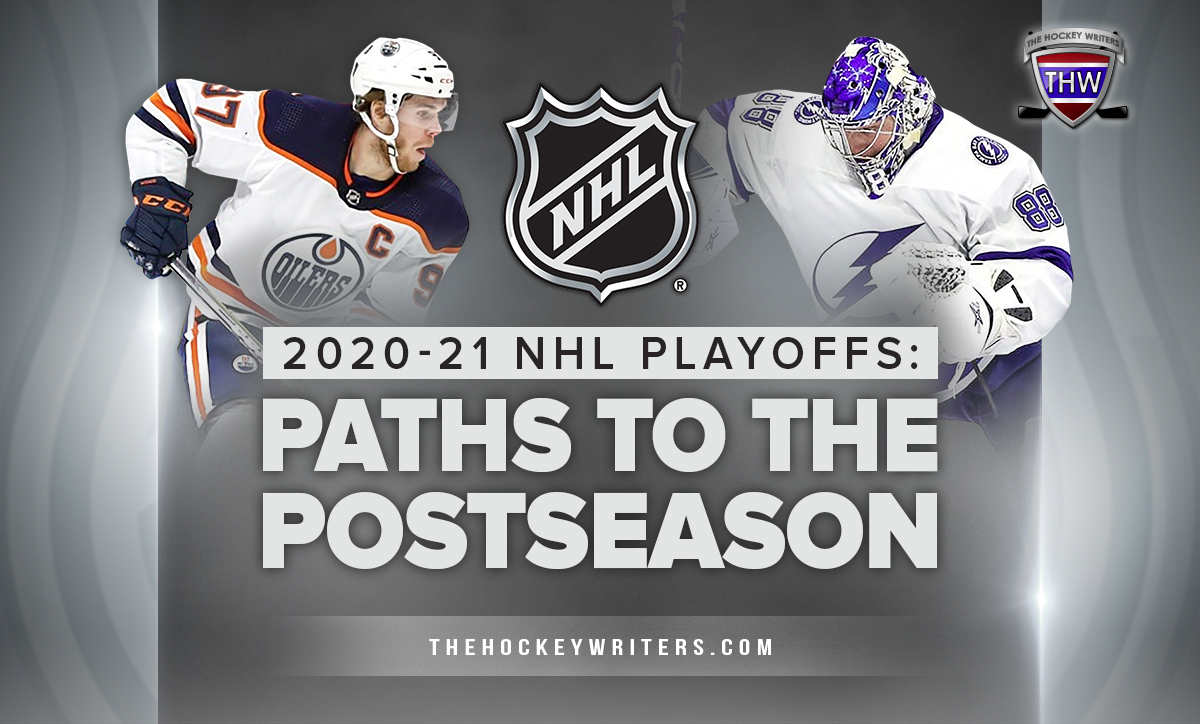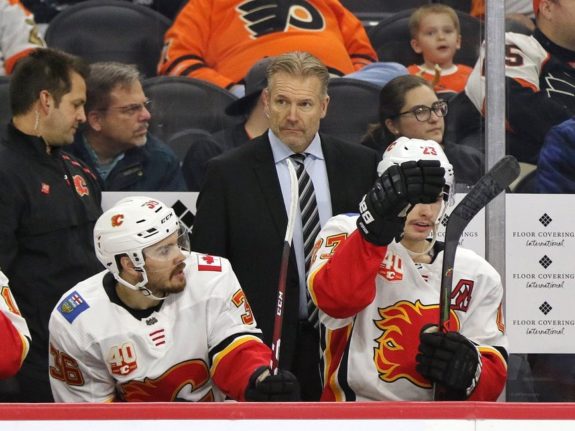With well over one-third of the 2020-21 NHL regular season yet to be played, the Stanley Cup playoff picture is far from settled. While some teams seem comfortably in charge of their fates, there may be some scrambling and repositioning yet to come. I won’t be discussing odds or percentages — there are websites that specialize in those numbers. Instead, let’s look at actual games and schedules.

Remember that in this unique (we hope) schedule, playoff qualification and positioning will be determined exclusively within each division. And the first two rounds of the playoffs will also be matchups within the divisions. Here’s a look at which teams are pretty much locks for the playoffs at this point and which teams have playoff chances — good, long, fat, and slim.
(Pretty) Sure Bets for the Playoffs
Some teams would need a major breakdown — no make that “melt down” — to miss the playoffs at this point. Yes, it can happen, but these teams are more likely to be fighting for positioning rather than struggling to stay in a playoff slot.
Scotia North Division
The Toronto Maple Leafs, Winnipeg Jets, and Edmonton Oilers all seem poised for playoff positions. In the initial five THW Power Rankings of 2020-21, the Maple Leafs ranked third, fourth, first, first, and fourth. But the month of March isn’t being kind. After a couple of strong wins over the Oilers, the team had trouble handling the Vancouver Canucks, Jets, and even the lowly Ottawa Senators.

The Oilers started slowly, winning just four of 11 January games in regulation and one more in overtime. Then things started to click, with three wins in a row, followed closely by a pair of four-game winning streaks. Winnipeg has been much more consistent, never losing more than two games in a row (so far).
MassMutual East Division
The New York Islanders, the Washington Capitals, and the Pittsburgh Penguins are all looking good (right now) for playoff slots, although they’re likely to be jockeying for seeding in the top three slots.

The Islanders had a rough stretch at the end of January, losing five straight (two in overtime). Mid-February produced a promising three-game win streak, but the real surge to the top started at the end of that month with a nine-game winning streak that continued into mid-March. The Capitals needed some time to put things together. It was win one/lose one, win two/lose two, short winning streak/short losing streak to open the season. Then the wins started to outnumber the losses. And then the wins started piling up, including a current six-game streak that puts the Capitals at 10–1–0 in their past 11 games. The Penguins were just about a .500 team until the second half of February. Since then, there have only been a few losses sprinkled among a lot of wins.
Discover Central Division
The Tampa Bay Lightning, Carolina Hurricanes, and Florida Panthers seem to be switching their positions at the top of the Central Division on a near-daily basis. But those three teams are not only the class of the division, they’re among the cream of the crop league-wide.

The Lightning have only a half-dozen regulation losses spread through the first half of their season and the same can be said about the Hurricanes, while Florida had only five regulation losses in the first half. Another thing the three clubs have in common: each has had at least three games postponed due to COVID-19. Make-up games might crowd the schedule in places down the stretch.
Honda West Division
What to say about the West Division? The No. 1 team is 11 points ahead of the No. 5 team, so that looks safe. And the teams in the second through fourth slots are between seven and five points up on the fifth and sixth teams. But if either of those lower-ranked teams goes on a five- or six-game winning streak and any team above them hits a losing skid between now and the end of the regular season, who knows?

The West division has already seen a couple of six-game win streaks (Vegas Golden Knights, Minnesota Wild, which also has a current five-game streak going). One team, the Los Angeles Kings, has seen losing streaks of three-, five-, and four-games, yet remains within a few points of a playoff slot. Another team has had three losing streaks of at least three games (St. Louis Blues), but is currently in a playoff spot. The West playoff race is on the verge of becoming a circus, only more entertaining.
Bubble Playoff Teams – And What Needs to Happen for Each Team
As much as I’d like to make solid, “trust me on this” predictions, there isn’t one of the four divisions that appears clearly in my crystal ball right now. However, that won’t stop me from making some observations about how the playoff races look at this point in the season.
Scotia North Division
The Maple Leafs are one of three teams to score more than 100 goals so far this season (Edmonton and Washington are the others). Despite a falloff in the past week or so, they’re still nine points clear of the division’s fifth-place team, the Calgary Flames. Seems safe, right? Yeah, pretty much. The Jets and Oilers are only four points behind Toronto, but they’re only five points up on the Flames.
However, it’s the fourth-place team in the Scotia North Division that’s intriguing right now. The Montreal Canadiens had a five-game losing streak Feb. 20–27, although they did pick up three points, the so-called “loser point,” a point in the standings earned for losing a game in overtime or a shootout. (Interestingly, Montreal has yet to surrender a loser point in wins beyond regulation time this season.) The Flames and Canucks are nipping at the heels of the Canadiens. The Flames are two points behind and have played one more game; the Canucks are three points back, but have played four more games.
Related: Canadiens & Bergevin Have Trade Deadline Needs & Targets
The Canadiens play Winnipeg (once), Vancouver (twice), and Edmonton (three times) over the next six games. They likely need to come out of that stretch with at least six points to remain healthy in the standings. They get a break, though, right after that. No, not days off, but perhaps even better: four straight games against the division bottom-feeding Senators. Other than one more game against Ottawa on May 1, the rest of Montreal’s schedule is tough. Eight points against the Senators would be a nice cushion for the stretch run.
The Flames have 27 games left in this season, including four against Ottawa. That’s the good news. They also have five games remaining against both Toronto and Edmonton, as well as four vs. the Jets. That’s the bad news. The most important news: Calgary has five games remaining against Montreal. If they can dominate that series (and avoid surrendering loser points), their chance of earning a playoff spot rises tremendously.

Vancouver’s remaining two dozen games include a pair against Montreal, as well as five with the Senators. Thirteen games against the division’s top three teams — Toronto, Winnipeg, and Edmonton — likely require at least a split. But the key for the Canucks will perhaps be their four remaining games head-to-head with Calgary. And the last of those games is the last of each teams’ regular season. Could the final playoff spot in the Scotia North Division come down to their last game of the regular season? You betcha!
MassMutual East Division
While there’s likely to be some back-and-forth movement among the top three seeds in the MassMutual East Division (the Islanders, Capitals, and Penguins), the battle for the final playoff position is the current focus. The Boston Bruins and the Philadelphia Flyers are separated in the standings by a mere three points, although the Bruins have played one more game. In the first five THW Power Rankings, the Bruins placed second, first, third, seventh, and 10th. The Flyers were seventh, ninth, 12th, 11th, and not-in-the-top-13. (By points, Philadelphia was 15th last week, but we technically only rank the top 13.)
The rankings would indicate that the Bruins are a no-brainer pick over the Flyers for the final playoff spot in the East. The Bruins have 29 games left to play, including a dozen against the Buffalo Sabres and New Jersey Devils, both positioned very well right now — for the Entry Draft Lottery, not the playoffs. There are also five games against the not-there-yet-but-improving New York Rangers. That should bode well for the Bruins.

The Flyers’ remaining 30 games include six against the Devils (they have a four-game series near the end of the season), three with the Sabres, and five vs. the Rangers. That leaves 16 games against the division’s top four teams (at least for the moment), including a stretch of five games and two stretches of four games against those current playoff teams. It could be brutal. For the Flyers to overtake the Bruins, they’ll have to come up big against both the Bruins and the division leaders, often for consecutive games.
Am I handing the final division playoff spot to the Bruins? Not yet. In their past 14 games, their record is 5–7–2, while the Flyers are over .500 at 7–6–1. Can Philadelphia overtake Boston? It’s possible. The Flyers’ next 10 games include one in New Jersey and nine in the state of New York. If they can win the six games that are not against the Islanders and earn a split in the four that are against the Islanders, they’ll be in good position to face a brutal stretch prior to the trade deadline. Philadelphia’s first 10 days of April include three games against the Bruins and two more with the Islanders. Keep an eye on those Flyers vs. Bruins games just before the trade deadline!
Discover Central Division
The top-heavy Central Division could be interesting in the weeks leading up to the trade deadline. Any of four teams could land the final playoff spot in the division. The Chicago Blackhawks currently sit four points up on the Columbus Blue Jackets, eight points ahead of the Nashville Predators, and nine above the Dallas Stars. Those might seem like big gaps, but those teams chasing the Blackhawks might be closer than they appear in the mirror.
Of the three teams on the outside looking in at the fourth playoff slot in the Discover Central Division, Dallas may actually be the closest to challenging Chicago. The Stars, due to COVID-related postponements, have played only 25 games (to the Blackhawks’ 30 games) and they are at .500 right now, with 25 points in those 25 games. (Chicago has a .550 winning percent so far this season.) Let’s keep in mind that, as my colleague Sam Nestler reports, the Stars expect to get goalie Ben Bishop and forward Tyler Seguin back on the ice before the trade deadline in April.

The Stars will be playing 31 games over the remainder of the regular season, which is a lot compared to most other teams. However, they probably won’t complain about the schedule — they have five games against the lowly Detroit Red Wings, as well as five with Nashville, from whom they’ve taken five of a possible six points so far this season. They will have to punch above their weight, though, to make the playoffs. Dallas has lost all four games with Carolina, all three against Tampa Bay (two in regulation and a shootout loss), two of three against Florida, and so far they have just an even split with Columbus over six games (both teams are 3–2–1).
On the subject of the Blue Jackets, some fans and members of the media are already throwing in the towel and talking about trading away key players for picks and prospects to bolster the future. If the goal is the Stanley Cup, not just extending the club’s streak of making the playoffs (currently four straight seasons), then perhaps those folks are correct — even if the club’s record against the top three teams in the division is 3-3-3 for a .500 record.
However, we need to look more closely at those loser points. Columbus is 1–0–1 against Tampa Bay, but the Lightning are 2–0–0 against the Blue Jackets. Columbus is 1–1–2 against Florida, but the Panthers are 3–0–1 against the Blue Jackets. Against Chicago, Columbus is 2–2–2, but the Blackhawks are 4–2–0 against the Blue Jackets. (Columbus is 1–2–0 against Carolina, so there are no loser points to discuss — so far — in that series.) The Blue Jackets may be 3–3–3 against the Lightning, Panthers, and Hurricanes, but those three teams are a combined 7–1–1 against the Blue Jackets. See how those loser points can distort one’s view of a team-vs.-team record?
Related: Blue Jackets Find a Consistent Line with Domi, Roslovic & Atkinson
Columbus has a four-game series against current division-leader Carolina coming up next. The team then gets a couple against Detroit, then it’s back into the fire with six games against Tampa Bay (four) and Florida (two). A pair of matchups at home against the Blackhawks bracket the trade deadline. If the Blue Jackets are not in a playoff position before then and don’t add substantially at the trade deadline, the team likely becomes chum for the division’s alpha teams to chew up as they battle for playoff positioning.
I didn’t forget about Nashville, but unless they improve significantly soon, they don’t belong in this conversation. Other than their most recent game, a 4–1 win over the Lightning, every regulation win for the Predators so far this season has come against Detroit or Columbus. That’s right, not a single regulation win against any of the other teams in the Discover Central Division — and they only have four overtime/shootout wins, one against the Panthers and none against the Lightning or Hurricanes. Right now, when it comes to the playoffs, the Predators need not apply. The time to start selling is now, before teams with needs shop elsewhere.
Honda West Division
As mentioned above, the Honda West Division playoff race has the potential for lots of drama in the coming weeks. Good news for the Kings and Arizona Coyotes: the Blues look to be in freefall. Currently holding the fourth playoff slot, St. Louis started the season 7–2–1, but has been basically a .500 team since. They’re on a four-game losing streak right now, with the most recent scheduled game postponed, keeping the losing streak alive-but-not-five. The Blues have earned five loser points, but surrendered four.
Related: 2020-21 NHL Season Stats: Comparing 56-Game & 82-Game Schedules
Remember that every loser point gained was one goal — scored or saved — from being a two-point win. Those are the kind of three-point games that can come back to bite a team on the backside, especially in this season, with teams playing only intra-divisional games.
The Kings sit outside the playoffs right now, but trail the Blues by only a handful of points, in part thanks to six loser points, three of which they gained against the Wild (a team now four points above the Blues). The Coyotes are in step with the Kings points-wise, but have played two more games. I’d love to include the San Jose Sharks in the “playoffs are possible” category, but the club has already decided to “reset” (not to be confused with a “rebuild”).

While the past 10 games have not been stellar for any of the Blues, Kings, and Coyotes, whichever team does best from now until the trade deadline could be the frontrunner for that fourth playoff spot in the West. Of the three, Arizona has the least challenging schedule, but the key games may be Kings vs. Blues (twice) and Kings vs. Coyotes (twice). Those head-to-head games may be the deciding factor in the playoff race. And watch for those loser points! Great if one of these three teams gains them, bad if they lose ‘em, especially against one of the other three.
Remember, too, that Minnesota and the Colorado Avalanche are within a losing streak of falling into this conversation. Right now, both teams are playing well and each has only a pair of games against the Golden Knights between now and the trade deadline. But this is the Honda West Division. (I’d like to make a nomination for the West Division Official Motto: “Wait and see!”)
Stay Tuned!
The NHL’s Trade Deadline is creeping up on us — April 21, 2021. Between now and then, watch for bubble teams making trades. If a team, say San Jose or Columbus, starts selling off assets, you’ll know the club (not necessarily the players) has thrown in the towel on this season. If a team starts mortgaging its future by trading picks and prospects for roster players in the next couple of weeks, you know they’re making a run for the playoffs.

Pay special attention to teams in the Scotia North Division trading with U.S.-based teams. Any player headed across the border to Canada will need to sit for two weeks in quarantine (under current rules and guidelines). The buying team must really want the player to wait not only those two weeks, but also for the player to acclimate and adjust to his new team, and to get back into game shape.
And then there’s the trade deadline itself. Those final moves (if any) will define a team’s plan for this season and beyond. Look to the future? Aim to make the playoffs? Make a run for the Cup? All should be clear when the trade deadline dust settles. Maybe.